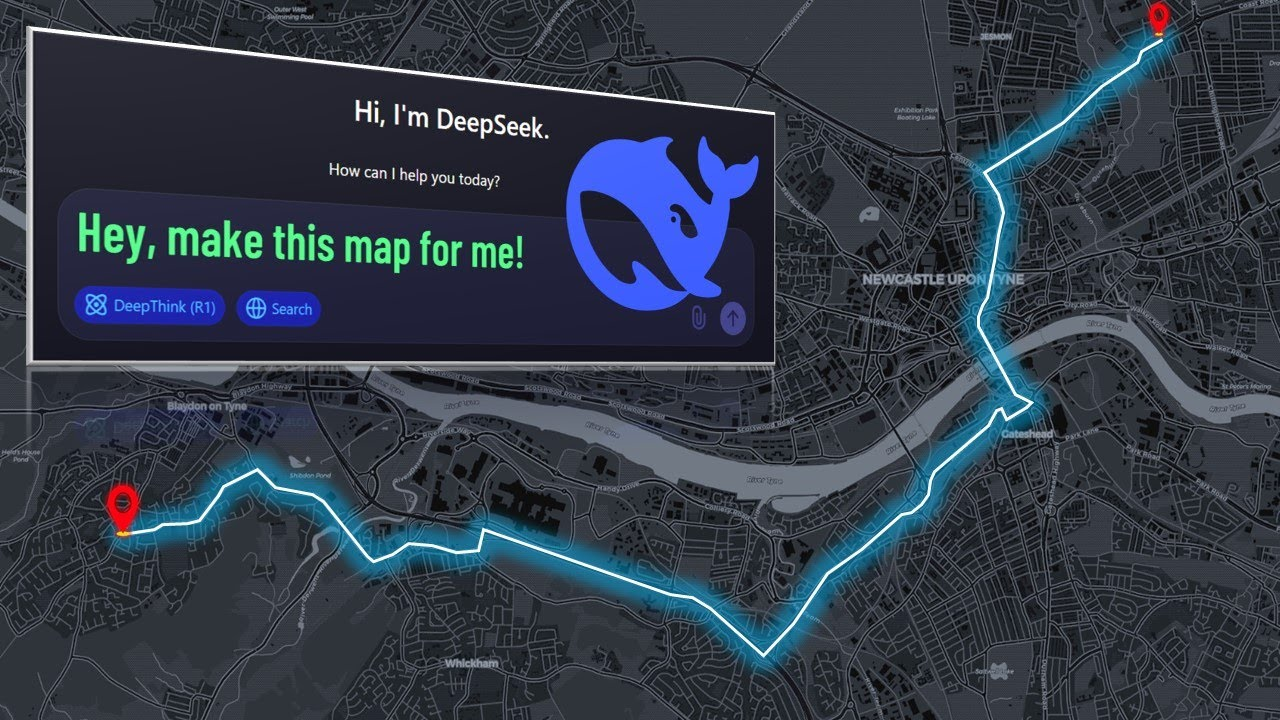Geographic Information Systems (GIS) have long been a cornerstone of spatial analysis, enabling us to visualize, interpret, and understand the world around us. From urban planning to environmental monitoring, GIS has revolutionized how we interact with geographic data. But as the volume and complexity of geospatial data grow, traditional GIS methods are struggling to keep up. Enter Artificial Intelligence (AI). AI, particularly advanced platforms like DeepSeek, is poised to transform GIS, making it faster, smarter, and more efficient than ever before. In this article, we’ll explore what GIS is, how AI is revolutionizing it, and why tools like DeepSeek are at the forefront of this transformation.
What is GIS?
GIS, or Geographic Information Systems, is a framework for gathering, managing, and analyzing spatial and geographic data. At its core, GIS integrates hardware, software, and data to capture, store, and display information tied to specific locations. This allows users to visualize patterns, relationships, and trends in the form of maps, globes, reports, and charts.
Key Components of GIS
- Spatial Data: Information about the physical location and shape of objects (e.g., roads, rivers, buildings).
- Attribute Data: Descriptive information about spatial features (e.g., population density, land use type).
- GIS Software: Tools like ArcGIS, QGIS, and Google Earth that process and visualize geospatial data.
- Remote Sensing: The use of satellite or aerial imagery to collect data about the Earth’s surface.
GIS is widely used in fields like urban planning, disaster management, environmental science, and logistics. For example, city planners use GIS to design efficient transportation networks, while environmental scientists rely on it to monitor deforestation or track wildlife habitats.
The Current State of GIS Technology
While GIS has been a game-changer, traditional methods have limitations. Processing large datasets manually is time-consuming, and analyzing complex spatial relationships can be challenging. Additionally, the rise of real-time data from IoT devices and satellites has created a demand for faster, more scalable solutions.
Challenges in Traditional GIS
- Manual Data Processing: Labor-intensive workflows that slow down analysis.
- Limited Scalability: Difficulty handling massive datasets from sources like satellite imagery.
- Static Maps: Traditional GIS outputs are often static, lacking real-time updates or predictive capabilities.
Emerging Trends
- Cloud-Based GIS: Platforms like ArcGIS Online enable real-time collaboration and data sharing.
- Open-Source Tools: Software like QGIS is making GIS more accessible to smaller organizations.
- Integration with IoT: Combining GIS with Internet of Things (IoT) devices for real-time monitoring.
Despite these advancements, the true potential of GIS lies in its integration with AI.
How AI is Revolutionizing GIS
Artificial Intelligence is transforming GIS by automating repetitive tasks, enhancing data analysis, and enabling predictive modeling. By leveraging machine learning and deep learning algorithms, AI can process vast amounts of geospatial data with unprecedented speed and accuracy.
Key AI Techniques in GIS
- Deep Learning Algorithms: These are particularly useful for analyzing satellite imagery. For example, AI can automatically detect and classify objects like roads, buildings, and vegetation.
- Predictive Modeling: AI can forecast future trends, such as urban growth or the impact of climate change, by analyzing historical spatial data.
- Neural Networks: These are used to identify patterns in large datasets, such as predicting traffic congestion or identifying areas at risk of natural disasters.
Benefits of AI in GIS
- Automation: AI reduces the need for manual data processing, saving time and resources.
- Enhanced Accuracy: Machine learning algorithms improve the precision of spatial analysis.
- Real-Time Insights: AI enables dynamic, real-time updates to GIS maps and models.
DeepSeek: A Case Study in AI-Driven GIS Innovation
DeepSeek is an advanced AI platform that exemplifies how AI can revolutionize GIS. By combining machine learning with geospatial data, DeepSeek automates complex workflows and delivers actionable insights.
Applications of DeepSeek in GIS
- Automated Feature Detection: DeepSeek can analyze satellite imagery to identify infrastructure like roads, buildings, and water bodies with minimal human intervention.
- Real-Time Spatial Analysis: During disasters, DeepSeek can process real-time data to predict flood risks or optimize evacuation routes.
- AI-Powered GIS Mapping: DeepSeek generates dynamic, data-rich maps that update in real time, providing users with the most current information.
Benefits of DeepSeek
- Efficiency: Automates time-consuming tasks, freeing up GIS professionals to focus on strategic decision-making.
- Scalability: Handles massive datasets with ease, making it ideal for large-scale projects.
- Cost-Effectiveness: Reduces the need for manual labor, lowering operational costs.
Real-World Use Cases
Urban Planning
AI-powered GIS tools like DeepSeek are helping city planners design smarter cities. For example, AI can analyze traffic patterns to optimize road networks or predict future housing needs based on population growth.
Environmental Monitoring
Satellite imagery analysis powered by AI is being used to track deforestation, monitor wildlife habitats, and assess the impact of climate change. DeepSeek’s algorithms can detect subtle changes in vegetation or land use, providing early warnings of environmental degradation.
Disaster Management
During natural disasters, AI can process real-time data to predict flood risks, identify safe evacuation routes, and allocate resources efficiently. DeepSeek’s predictive modeling capabilities are particularly valuable in these high-stakes scenarios.
Challenges and Ethical Considerations
While AI holds immense potential for GIS, it’s not without challenges. Data quality and bias are significant concerns, as AI models are only as good as the data they’re trained on. Privacy is another issue, especially when dealing with location-based data. Additionally, there’s a need for human oversight to ensure that AI outputs are accurate and ethical.
The Future of GIS with AI
The integration of AI and GIS is still in its early stages, but the possibilities are endless. Emerging trends like generative AI, edge computing, and IoT integration are set to take GIS to new heights. For example, generative AI could create synthetic geospatial data for training models, while edge computing could enable real-time analysis in remote areas.
Why Businesses Should Care
AI-powered GIS tools like DeepSeek offer businesses a competitive edge by providing faster, more accurate, and cost-effective geospatial solutions. Whether you’re in logistics, real estate, or environmental science, AI can help you make smarter, data-driven decisions.
Conclusion
GIS has come a long way since its inception, and AI is taking it to the next level. By automating workflows, enhancing accuracy, and enabling real-time insights, AI platforms like DeepSeek are transforming GIS into a dynamic, predictive tool. As we look to the future, the synergy between AI and GIS will continue to unlock new possibilities, helping us better understand and navigate our world.
FAQ
1. What is the role of AI in geospatial analysis?
AI automates tasks like feature extraction, image classification, and predictive modeling, making geospatial analysis faster and more accurate.
2. How does machine learning improve GIS accuracy?
Machine learning algorithms can identify patterns and anomalies in large datasets, improving the precision of spatial analysis.
3. Can AI replace GIS professionals?
No, AI augments the work of GIS professionals by automating repetitive tasks and providing deeper insights, but human oversight remains essential.
By embracing AI-powered tools like DeepSeek, we can unlock the full potential of GIS and create a smarter, more connected world.

